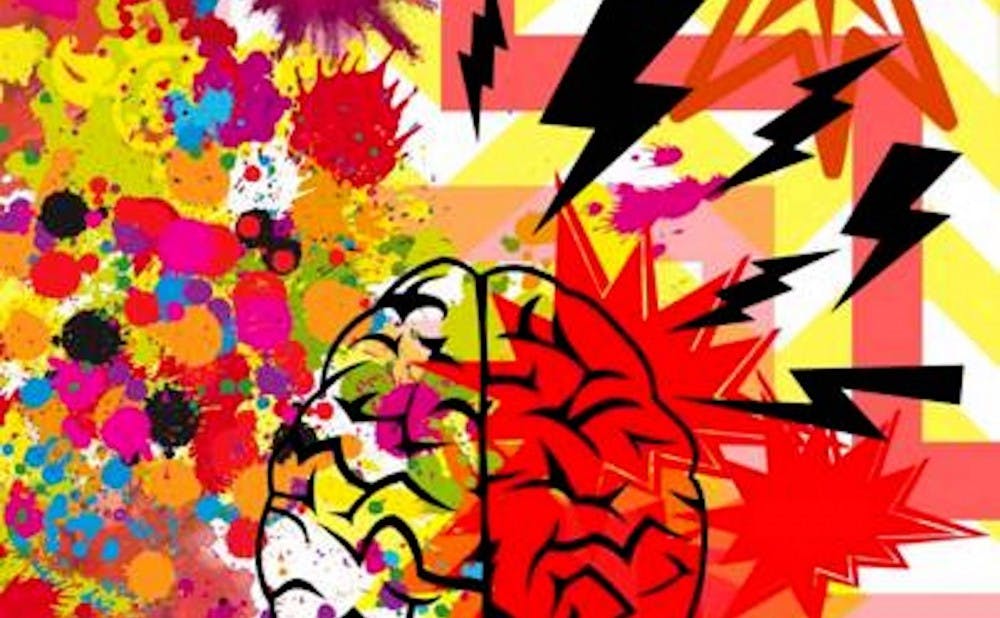What is “normal”? How do socially-constructed conceptions of normalcy limit the types of narratives that are constructed and propagated? By challenging normalcy, how do we both innovate art as well as successfully incorporate and acknowledge marginalized identities?
These three questions were at the heart of the Disability Pride Student Expo, held last Wednesday at Smith Warehouse as part of the Duke Disability Alliance’s Disability Pride Week. The event was organized by Marion Quirici, instructor of the Writing 101 class “Neurodiversity Narrative Activism” and DDA’s faculty advisor, as well as Jim Haverkamp of the Arts of the Moving Image program. The expo showcased activism projects created by students in Quirici’s Writing 101 class, who aimed to combine art and advocacy by utilizing narrative in order to deconstruct social structures regarding disability and neurodiversity.
“We must challenge the idea of normalcy, because it is often this very narrow and restrictive category that can be oppressive, and it’s one that is socially constructed anyway,” Quirici said. “So I think it is important to avoid thinking about disability as being in binary opposition to the category of normalcy.”
At the heart of students’ projects is a reconceptualization of disability as a form of diversity. This new way of thinking about disability has had two major effects, one artistic and the other primarily social and political. By considering disability as one acknowledges race, gender, sexuality or religion, new pathways emerge within art that allow artists to push the boundaries of their chosen medium, whether it be writing, filmmaking, dance or photography. This dialogue on the intersection between art and disability was the centerpiece of the Disability Alliance’s Pride Week, which culminated in a Disability and the Arts showcase held this past Saturday at the Nasher Museum of Art.
Nonetheless, the student expo focused on another aspect of disability as diversity: the role that social and cultural structures play in reinforcing stigmas about disability.
“The projects that my students created were activism projects, all of which were focused on social structures,” Quirici said. “So rather than focusing on mental health patients, it’s more about looking at the way our environments can produce barriers that exclude people from participation.”
These barriers can be explicit, in the form of a dearth of physical accommodations that prevent those with disabilities from being active members of society. At Duke, members of the Disability Alliance including President Jay Pande have leveled complaints against the administration, which they assert has been slow to provide physical accommodations in the Broadhead Center, the Languages Building and the Art Building on East, and has made classroom accommodations difficult to access. A number of students at the expo documented the lack of accommodations for those with disabilities at Duke through video projects and op-eds, the former of which include interviews with Pande and will be uploaded to the Disability Pride Week website within a week.
Other projects focused on the implicit role that social constructs play in “othering” those with disabilities. Media portraying negative conceptions of disability continue to be celebrated, not criticized, which is evident in the critical acclaim received by films like “The Shape of Water,” which implies that those with disabilities must “be with their own kind” in order to feel a sense of belonging. A number of students at the expo assessed current representations of disability in mainstream media, while others endeavored to make media of their own that positively represented those with disabilities.
First-years Jay Patel and Nick Saba aim to do the latter in their children’s book, “New Friends.” Their story follows Bridget, a young student with autism integrating into a new elementary school. Patel and Saba centered their children’s book on the message that a person with autism simply sees the world differently, and this added element of diversity does not change the fact that all kids, regardless of race, gender or differing forms of ability, want to play and have fun.
“In the book, all of the friends are playing a game with Bridget, our autistic character. Whenever she wins a game, she celebrates by humming loudly, which is something that is associated with people with autism,” Patel said. “One thing we made clear is that just because Bridget celebrates in a different way doesn’t mean it’s weird. We want to battle the concept of ‘normal.’”
As part of their project, Patel and Saba are visiting local elementary schools and presenting their work to students. They have received positive feedback, pointing to the need for new narratives on diversity.
“At every school that we went to and read this book to, everyone understood the concepts and got the message,” Saba said. “There wasn’t a single school we went to that didn’t understand the book and didn’t have good dialogue about it.”
Good representation of people with disabilities hinges on challenging what is deemed normal and acceptable. Although present representation seems bleak, efforts like the Disability Pride Expo and the DDA’s Disability Pride Week challenge non-disabled people to consider how marginality pushes the boundaries of art and media.
Get The Chronicle straight to your inbox
Sign up for our weekly newsletter. Cancel at any time.

